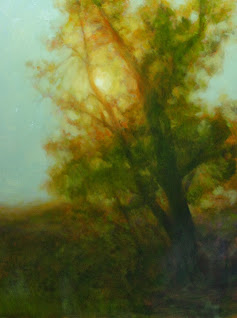by Lisa Larrabee
Westward Moon
2nd Place Acrylic & Oil, Richeson 75
International Competition
24" x 18"
artist Lisa Larrabee
Sunrises and sunsets are so beautiful that it can be hard to take your eyes away from them and turn around. When you do, the reward can be equally as great. Capturing the blazing red-orange light hitting the tops of the trees with the moon still overhead was my goal. This began as a demo that I did over two painting sessions for my Acrylic & Oil painting class. The final session was painted in my studio.
In the first class, I used Gamblin Gamsol (OMS) to thin Transparent Earth Red to cover the panel (oil primed linen). With a little OMS on my brush, I lifted out the moon and wiped it white with a paper towel. The trees were blocked in with a little Cobalt added to the mix. What I love about this method is that I can adjust and move around elements on my panel with incredible flexibility. It is my new favorite way to begin!














